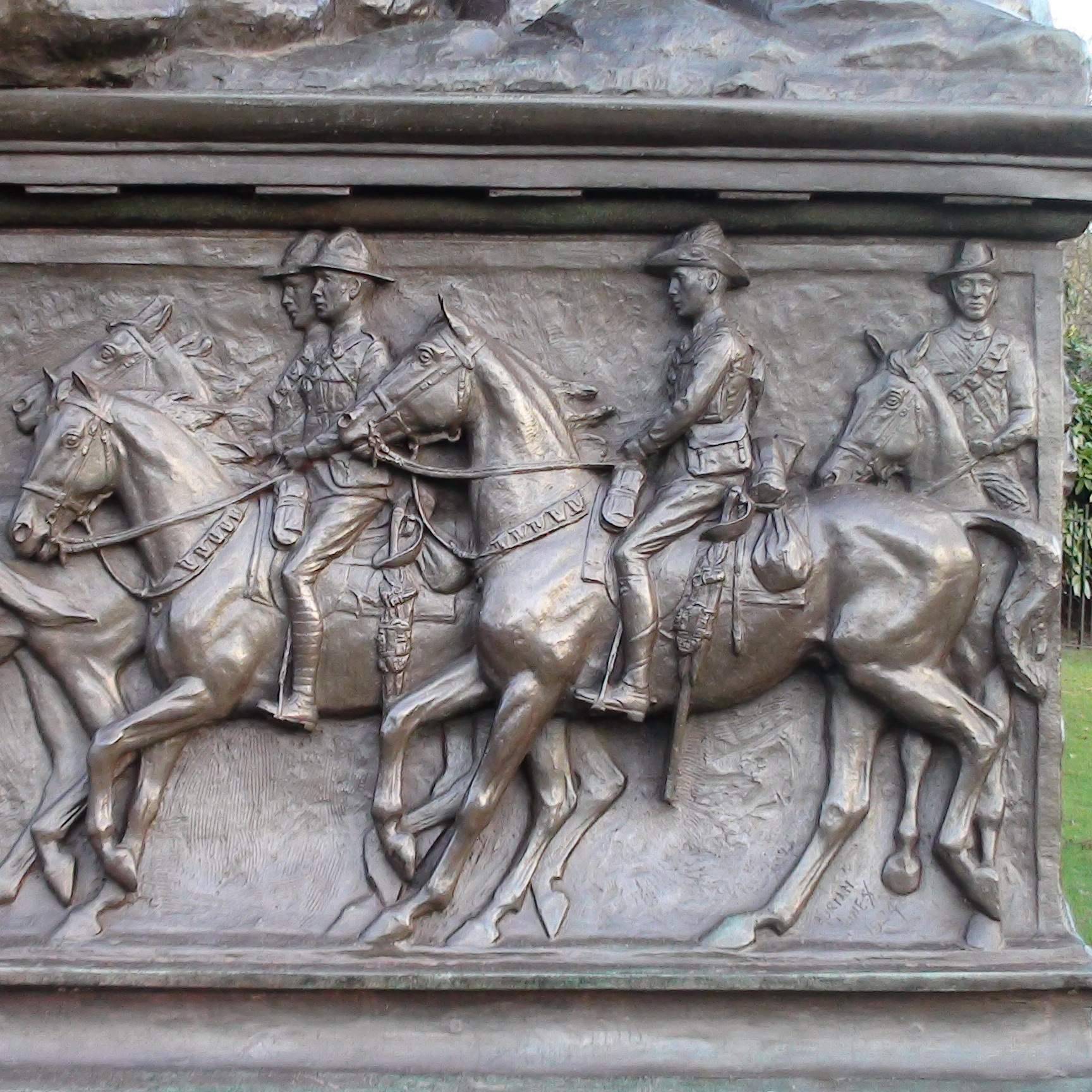Erection date: 1961
{On the front of the plinth:}
Erected by the cavalry of the Empire in memory of comrades who gave their lives in the war 1914 - 1919, also in the war 1939 - 1945 and on active service thereafter.
{This text was extended to include the post-WW1 period in 1961 when the monument was moved.}
{On a corner of the ground at the horse's hooves:}
Adrian Jones, Sc.
{On the frieze:}
Adrian Jones, 1924
{On the screen behind the statue:}
Cavalry of the Empire
1914 - 1919
1st Life Guards
2nd Life Guards
Royal Horse Guards
King’s Dragoon Guards
Queen’s Bays
3rd Dragoon Guards
4th Dragoon Guards
5th Dragoon Guards
Carabiniers
7th Dragoon Guards
Royal Dragoons
Scots Greys
3rd Hussars
4th Hussars
5th Lancers
Inniskilling Dragoons
7th Hussars
8th Hussars
9th Lancers
10th Hussars
11th Hussars
12th Lancers
13th Hussars
14th Hussars
15th Hussars
16th Lancers
17th Lancers
18th Hussars
19th Hussars
20th Hussars
21st Lancers
---
North Irish Horse
South Irish Horse
King Edward’s Horse
2nd King Edward’s Horse
YEOMANRY
Royal Wiltshire
Warwickshire
Yorkshire Hussars
Sherwood Rangers
Staffordshire
Shropshire
Ayrshire
Cheshire
Yorkshire Dragoons
Leicestershire
North Somerset
Duke of Lancaster’s Own
Lanarkshire
Northumberland
South Notts Hussars
Denbighshire
Westmoreland & Cumberland
Pembroke
Royal East Kent
Hampshire
Buckinghamshire
Derbyshire
Dorset
Gloucestershire
Herts
Berks
1st County of London
Royal 1st Devon
Suffolk
Royal North Devon
Worcestershire
West Kent
West Somerset
Oxfordshire
Montgomeryshire
Lothians and Border Horse
Queen’s Own Royal Glasgow
Lancashire Hussars
Surrey
Fife and Forfar
Norfolk
Sussex
Glamorgan
Welsh Horse
Lincolnshire
City of London
2nd County of London
3rd County of London
Bedfordshire
Essex
Northamptonshire
East Riding of Yorkshire
1st and 2nd Lovat’s Scouts
Scottish Horse
INDIA
1st Lancers
2nd Lancers
3rd Skinner’s Horse
4th Cavalry
5th Cavalry
6th Cavalry
7th Lancers
8th Cavalry
9th Hodson’s Horse
10th Lancers
11th Lancers
12th Cavalry
13th Lancers
14th Lancers
15th Lancers
16th Cavalry
17th Cavalry
18th Lancers
19th Lancers
20th Deccan Horse
21st Cavalry F. F.
22nd Cavalry F. F.
23rd Cavalry F. F.
25th Cavalry F. F.
26th Light Cavalry
27th Light Cavalry
28th Light Cavalry
29th Lancers
30th Lancers
31st Lancers
32nd Lancers
33rd Light Cavalry
34th Poona Horse
35th Sind Horse
36th Jacob’s Horse
37th Lancers
38th Central India Horse
39th Central India Horse
Guides Cavalry
Aden Troop
---
Alwar Lancers
Bhavnagar Lancers
2nd Gwalior Lancers
3rd Gwalior Lancers
Hyderabad Lancers
Indore Mounted Escort
Jodhpur Lancers
Kashmir Lancers
Mysore Lancers
Patiala Lancers
Ratlam Despatch Riders
AUSTRALIA
1st, 2nd and 3rd Light Horse
5th, 6th and 7th Light Horse
8th, 9th and 10th Light Horse
4th, 11th and 12th Light Horse
13th Light Horse
14th and 15th Light Horse
CANADA
Royal Canadian Dragoons
Lord Strathcona’s Horse
Fort Garry Horse
Canadian Light Horse
NEW ZEALAND
Auckland Mounted Rifles
Wellington Mounted Rifles
Canterbury Mounted Rifles
Otago Mounted Rifles
SOUTH AFRICA
South African Horse
Mounted Rifles
Rhodesia Mounted Forces
Ist Imperial Light Horse
2nd Imperial Light Horse
East African Mtd Rifles
{In the 4 laurel wreaths:}
French
Haig
Allenby
Robertson
Unveiled in its original location, at Stanhope Gate by the Dorchester Hotel, by the Prince of Wales (Edward VIII to be), French and Connaught. Haig and Robertson were also present.
The statue represents St George slaying the dragon, which is shown with an upturned moustache, just like the Kaiser's.
Normally we would photo the face of the statue but this one is particularly unappealing so we have used the frieze instead - we do like the way the parade of riders is shown turning the corner. However when the design was first displayed the formation of the marching column was criticised as showing each pair too close to the one in front - health and safety, basically. Ornamental Passions points out that the headgear of the riders identifies riders from the various countries of the Empire.
The background bronze tablet was part of the original design and lists all the cavalry units of the Empire which took part in the war. The design of this tablet has the lists separated by representations of four field-marshals' batons each above a name surrounded by a laurel wreath. The names are of the four cavalry officers who became field-marshals during the war and who also survived: Haig, French, Allenby and Robertson.
Site: Cavalry Memorial (1 memorial)
W2, Hyde Park, Serpentine Road
This memorial was moved here from its previous location.
This was erected after 'the war to end all wars' and then, as with many war memorials, the inscription was extended following the next war.
The Parks website tell us: "Cast from guns captured in World War I. Originally it stood at Stanhope Gate which was altered to accommodate it. Moved to present site in 1961 when Park Lane was widened." That widening turned 'Stanhope Gate' into the motorway-style right turn off Park Lane into the road that is now called Stanhope Gate, previously Great Stanhope Street.
The Western Front Association provides the full story of how this memorial was erected. The original site was chosen for its prominence and for its position on a military procession route. We doubt that still applies. The WFA's pictures include some, rather murky, of the memorial in its original location.
We were delighted to find, in a 1938 film, an image of the memorial at Stanhope Gate, taken from high up in the Dorchester Hotel, showing its setting very well.
The second Sunday in May is named Cavalry Sunday and is marked with The Combined Cavalry Old Comrades Association Memorial Parade. This normally consists of a march past this memorial and a short service.
2019: The Daily Mail carries photos of the Parade and they are worth a glance: "The event, which honours soldiers lost in conflict since the First World War, has a strict dress code - Twenties city attire including a bowler hat - because that's the decade in which the parade first began." Prince Charles is particularly, em, fetching."
















Comments are provided by Facebook, please ensure you are signed in here to see them